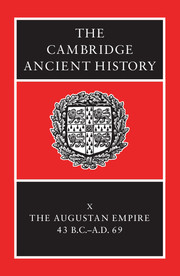Crossref Citations
This Book has been
cited by the following publications. This list is generated based on data provided by Crossref.
Keaveney, A. P.
1997.
Roman History.
Greece and Rome,
Vol. 44,
Issue. 1,
p.
95.
Campbell, Brian
2005.
The Cambridge Ancient History.
p.
110.
Carrié, Jean-Michel
2005.
The Cambridge Ancient History.
p.
269.
2005.
A Companion to Latin Literature.
p.
406.
Johnston, David
2005.
The Cambridge Ancient History.
p.
200.
Cascio, Elio Lo
2005.
The Cambridge Ancient History.
p.
170.
Bowman, Alan K.
2005.
The Cambridge Ancient History.
p.
313.
Cascio, Elio Lo
2005.
The Cambridge Ancient History.
p.
131.
Cascio, Elio Lo
2005.
The Cambridge Ancient History.
p.
156.
Cascio, Elio Lo
2005.
The Cambridge Ancient History.
p.
137.
Bowman, Alan
Cameron, Averil
and
Garnsey, Peter
2005.
The Cambridge Ancient History.
Wilkes, John
2005.
The Cambridge Ancient History.
p.
212.
Ibbetson, David
2005.
The Cambridge Ancient History.
p.
184.
Scheidel, Walter
Morris, Ian
and
Saller, Richard P.
2007.
The Cambridge Economic History of the Greco-Roman World.
Edwards, Ronald A
2009.
FEDERALISM AND THE BALANCE OF POWER: CHINA'S HAN AND TANG DYNASTIES AND THE ROMAN EMPIRE.
Pacific Economic Review,
Vol. 14,
Issue. 1,
p.
1.
Hoyos, Dexter
2011.
The Encyclopedia of War.
2011.
Christ Identity.
p.
349.
Eich, Peter
2012.
The Encyclopedia of Ancient History.
Rich, J. W.
2012.
The Encyclopedia of Ancient History.
2013.
The Rise of Gay Rights and the Fall of the British Empire.
p.
40.



